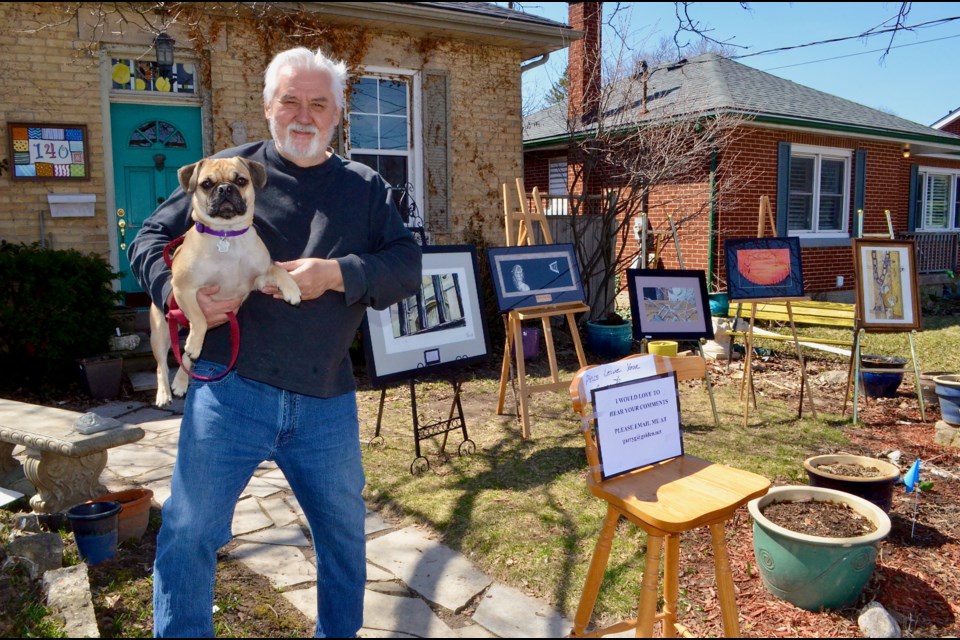Being under quarantine has given us all a small taste of what incarceration feels like and social media is flooded with posts from people using art to share their experiences and perspectives about being in isolation.
But Garry Glowacki’s art collection provides a glimpse from the inside most of us will never see.
“I have talked to a couple different prisoners and described this as a different kind of segregation,” said Glowacki.
When GuelphToday first met Glowacki last November when he was preparing for an art exhibit at HOPE House featuring works by prisoners called Art Inside Out: From the Hearts and Souls of Men and Women Imprisoned.
The exhibition showcased works he has collected over more than 25 years as a restorative justice advocate and executive director of the Bridge Prison Ministry.
Glowacki has been watching the public’s response to the pandemic and selected a few pieces from his collection to display in front of his home on Metcalfe Street.
“I was getting discouraged watching people walk by with their hands in their pockets and their heads down some, not even saying hello,” he said. “I thought, you know what? I don’t want that fear to continue so I thought I would try to lighten up their walk. Apparently, it has worked. A lot of people have stopped by and taken pictures.”
Glowacki greets curious pedestrians from a safe distance, stepping back if they want to get a closer look at the works.
“It is prison art so, it is kind of out there,” he said pointing to a piece by Kingston Penitentiary inmate Brian Martland that shows a section of a locked prison cell door. “That is his view from his maximum-security jail cell where he spends 23 and a half hours a day, everyday. He painted it on a bed sheet because that’s all he had. He had some paints, but he couldn’t get anything beyond that.”
Among the more controversial pieces in his collection are by artist Peter Collins, who was serving a life sentence for killing Nepean Police Const. David Utman during a bank-robbery in 1983.
“Peter Collins died in prison in Millhaven in the 32nd year of a life sentence,” said Glowacki. “He was 17 when he killed a cop. He was a prison advocate, but they wouldn’t even let him out to go to hospice. He died alone in prison.”
The therapeutic value of creating art, especially under extreme conditions, is well documented and Glowacki spent decades promoting prison art programs and their rehabilitative benefits.
“My ministry was about reintegrating men back into the community,” he said. “That’s what I did and we ended up being very successful. It got national attention. It got lots of people jobs. Many, many people that a lot of people had given up on are doing okay.”
Glowacki retired in 2018 but he continues to advocate for prisoners and celebrate the redemptive qualities of artistic expression.
“Art Inside Out is the group I am trying to get together promoting this prison art,” he said. “I retired and went back to University of Guelph to study criminology so, I am hoping they get a little more tuned in to this too because it is an effective presentation.”
He believes that showing the art influences public perception in a positive way and said that people are often surprised to see how senstive and talented prison artists can be.
“I am hoping it is provocative,” he said. “I am hoping it provokes people to think. They have talent. They have feelings. They do.”
He is interested in hearing people’s opinions about the work and for a while he left a pen and a pad of paper for people to leave their remarks. He stopped that after a woman raised concerns about the pen and paper getting contaminated by someone carrying the virus.
He said he rarely gets negative responses from people when he exhibits the collection.
“What are you going to do,” he asked? “Are you going to tell me that you don’t like them? That’s fair or you can tell me you’re afraid of them. That’s fair too but they are still our brothers and sisters and you know what? They are getting out.”
For the time being, however, he has to limit any face-to-face discussions and keeps his distance when people pause to look at the exhibit in his yard.
“I don’t come out here too much,” he said. “Once in a while I will come out and say hi, thanks for coming.”
